

IVERMECTIN DOSE for DOGS, CATS, HORSES, CATTLE, SHEEP, GOATS, PIG, POULTRY and other domestic animals. Dosing recommendations for antiparasitics depend on national regulations.
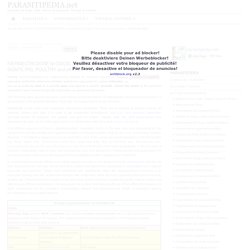
National regulatory authorities determine whether a product is approved for a given indication, i.e. use on a particular host at a specific dose and against a specific parasite. Check the labels of the products available in your country for specific information on approved indications. The following table reproduces some usual dosing recommendations for ivermectin issued by manufacturers or documented in the scientific literature. They may not be approved in some countries. Ivermectin is the most used veterinary antiparasitic worldwide. Ivermectin inhibits canine mammary tumor growth by regulating cell cycle progression and WNT signaling.
Cell lines and cell culture The CMT7364 [27] (Veterinary Teaching Hospital, China Agricultural University, Beijing, China) and CIPp [28] (Graduate School of Agricultural and Life Sciences, University of Tokyo, Tokyo, Japan) canine mammary tumor cell lines, and Madin-Darby immortalized canine kidney (MDCK) cells (Cell bank of the Chinese Academy of Science, Beijing, China) were grown in DMEM (C11995500BT,Gibco, USA) medium with 10% fetal bovine serum (FBS) (16,000,044, Gibco, USA), and penicillin (100 units/mL) and streptomycin (0.1 mg/mL) (C0222, Beyotime, China).
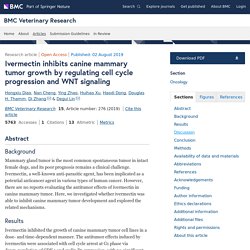
All cell lines were cultured in a humidified atmosphere with 5% CO2 at 37 °C. Cell proliferation evaluation Cell viability was evaluated using a Cell Counting Kit-8 (CCK-8) (CK04, Dojindo Molecular Technologies, Inc., Kumamoto, Japan). CMT7364, CIPp and MDCK were plated in 96-well plates at 1 × 104 cells per well and incubated overnight to allow attachment. Apoptosis assay. Natural product-derived Combination therapy for Squamous cell carcinoma of head and neck (HNSCC): A therapeutic mix encompassing Ivermectin and 1,25-dihydroxyvitamin D/Cholecalciferol may decrease BMI1 and AP-1 expression, overcome chemotherapeutic resist. Introduction: What they say: A study from the Laboratory of Molecular Signaling, Division of Oral Biology and Medicine, Jonsson Comprehensive Cancer Center and Broad Stem Cell Research Center, UCLA, Los Angeles, California, USA shows that inhibition of BMI1+ Cancer Stem Cells Overcomes Chemoresistance and Inhibits Metastases in Squamous Cell Carcinoma.

This study was published, in the 9 March 2017 issue of the journal “Cancer Stem Cell” [the number 1 research journal in Stem cell Biology with an I.F of 22.387+], by Prof. 0d694d5316c6174ee4e4d324f5c8c6902155. (125) m2ndr fenbendazole deciphered, information for healthcare professional including veterinarian. (125) Fenbendazole: Live Test on Non-Cancer Patient Day 61 - Every day for 61 days. (125) Fenbendazole: Live Test on Non-Cancer Patient Days 4, 5, 6. Episode 2. (125) m2ndr fenbendazole deciphered, information for healthcare professional including veterinarian. TREATING MELANOMA WITH MEBENDAZOLE AND A MITOGEN-ACTIVATED KINASE INHIBITOR - GEORGETOWN UNIVERSITY. This application claims priority to U.S.
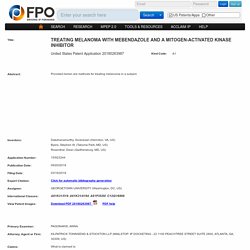
Provisional Application No. 62/472,374, filed Mar. 16, 2017, the entirety of which is incorporated by reference herein. It is estimated that, in 2017, about 87,110 new skin melanomas will be diagnosed and 9,940 people are expected to die of melanoma. Despite recent advances in treatment, the majority of patients with metastatic melanoma are likely to die of their disease.
Provided herein are methods for treating melanoma in a subject. The methods comprise administering, to a subject with melanoma, a wildtype BRAF inhibitor and a mitogen-activated protein kinase (MEK) inhibitor. FIG. 1A shows the structure of mebendazole (MBZ) with wildtype BRAF (BRAFWT) (left) or BRAFV600E (right), showing residues critical for binding; hydrogen bonds are shown as dotted lines. FIG. 1B shows a structure overlay of BRAFWT and BRAFV600E with MBZ. FIG. 1C is a table showing MBZ inhibition of kinase activity and binding affinities for different targets. 1. Mebendazole as a Candidate for Drug Repurposing in Oncology: An Extensive Review of Current Literature. Recent studies suggest that microtubule inhibitors synergize with ionizing radiations (IRs) not only during mitosis, but also during interphase [49] by interfering with the trafficking of DNA damage response proteins (DDRp).

Markowitz et al. combined IR with MBZ to treat human patient derived GBM14 glioblastoma and murine GL261 glioma cells [50]. In a viability assay, cells were treated with 25–150 nM MBZ either pre-IR or post-IR (when the mitotic index was 0%) and irradiated with 3–9 Gy. Repurposing Drugs in Oncology (ReDO)—mebendazole as an anti-cancer agent. (113) Panacur C on old drug they have found now to cure cancer. Fenbendazole as a Potential Anticancer Drug. Fenbendazole acts as a moderate microtubule destabilizing agent and causes cancer cell death by modulating multiple cellular pathways. FZ destabilizes tubulin network in human NSCLC cells Benzimidazole carbamates have been reported to inhibit tubulin polymerization and disrupt microtubule function in parasite cells16,17.
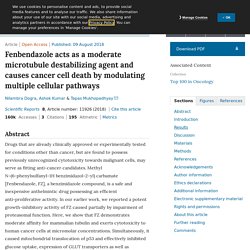
Results from in vitro studies using enriched extracts of helminthic and mammalian tubulin have suggested that tubulin is the primary molecular target of the benzimidazoles18. Therefore, to examine the effect of FZ on mammalian microtubule network organization, human non small cell lung carcinoma (NSCLC) A549 cells were treated with 1 uM FZ for 24 h and processed for immunofluorescence using α tubulin antibody. Colchicine was used as a positive control. Results showed that FZ treatment caused a partial alteration of the microtubule network (Fig. 1a). FZ treatment alters tubulin network of human cancer cells. The effect of FZ on tubulin polymerization was further evaluated by an in vitro assay. Tubulin acetylation has been associated with the stability of microtubules. A Cancer Cure Has Gotten Out of Control. While Wall Street awaits the entry of over 1,813 new cancer drugs into human clinical trials representing billions of dollars of investment capital, the announcement of a bona fide cure for cancer comes from an outsider – patient Joe Tippens.
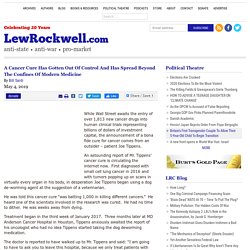
An astounding report of Mr. Tippens’ cancer cure is circulating the internet now. First diagnosed with small cell lung cancer in 2016 and with tumors popping up on scans in virtually every organ in his body, in desperation Joe Tippens began using a dog de-worming agent at the suggestion of a veterinarian. He was told this cancer cure “was batting 1,000 in killing different cancers.” He heard one of the scientists involved in the research was cured. Dog dewormer is very effective vs cancers; Articles & patents. Rexresearch.com Fenbendazole vs Cancer Fenbendazole Related: Mebendazole vs cancer 26 April 2017 Oklahoma grandfather who claims a drug for DOGS cured him of 'head-to-toe' cancer is tumor-free two years after doctors gave him three months to live By Natalie Rahhal.

A Drug Made for Animals and Taken by Humans to Treat Cancer: Fenbendazole - Blog: Cancer Treatments - from Research to Application. From anti-worms to anti-cancer Previously, we discussed on this website the anti-worm drug Mebendazole (Ref.), which based on a good amount of scientific and clinical evidence, shows relevant anti cancer potential.
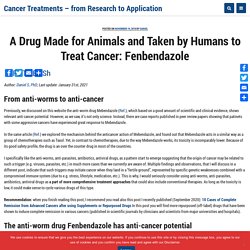
Indeed, there are case reports published in peer review papers showing that Mebendazole can induce anti-cancer response in some aggressive cancers. In the same article (Ref.) we explored the mechanism behind the anticancer action of Mebendazole, and found out that Mebendazole acts in a similar way as a group of chemotherapies such as Taxol. Yet, in contrast to chemotherapies, due to the way Mebendazole works, its toxicity is incomparably lower. Because of its good safety profile, the drug is an over the counter drug in most of the countries. Repurposing Drugs in Oncology (ReDO)—mebendazole as an anti-cancer agent - ecancer.
Pan Pantziarka1,2, Gauthier Bouche1, Lydie Meheus1, Vidula Sukhatme3 and Vikas P.

Impairment of the Ubiquitin-Proteasome Pathway by Methyl N-(6-Phenylsulfanyl-1H-benzimidazol-2-yl)carbamate Leads to a Potent Cytotoxic Effect in Tumor Cells. Antiparasitic mebendazole shows survival benefit in 2 preclinical models of glioblastoma multiforme. - PubMed - NCBI. Fenbendazole as a Potential Anticancer Drug. + Author Affiliations Correspondence to: Sara Rockwell, Department of Therapeutic Radiology, Yale University School of Medicine, PO Box 208040, New Haven, CT 06520-8040, U.S.A. e-mail: sara.rockwell@yale.edu Abstract Background/Aims: To evaluate the anticancer activity of fenbendazole, a widely used antihelminth with mechanisms of action that overlap with those of the hypoxia-selective nitroheterocyclic cytotoxins/radiosensitizers and the taxanes.
Materials and Methods: We used EMT6 mouse mammary tumor cells in cell culture and as solid tumors in mice to examine the cytotoxic and antitumor effects of fenbendazole as a single agent and in combination regimens. Results: Intensive treatments with fenbendazole were toxic to EMT6 cells in vitro; toxicity increased with incubation time and under conditions of severe hypoxia. Disclosure of complementary medicine use to medical providers: a systematic review and meta-analysis.
The effects of mebendazole and fenbendazole on Trichinella spiralis in mice. - PubMed - NCBI. The professor who 'cured' his cancer with a cocktail of everyday pills and 20 years on remains disease-free. “I’d been told that my chemotherapy wouldn’t get rid of the tumour completely or indefinitely, so I focused on finding agents that might make chemo work better for me,” he says.
Sure enough, after his fourth round of chemotherapy in 1996, Prof Williams’s tumour had vanished. It has never returned and thousands of people, including oncologists, have sought his advice since on ''beating'' a cancer known in medical circles as “The Terminator”. Man having an MRI scan (Alamy) In mainstream oncology Professor Williams is considered a freak case and his strategy of fighting cancer “using every potentially efficacious agent I could lay my hands on” attracts suspicion.
Yet a growing number of specialists and researchers say there is evidence that some of the common pills taken daily by millions for other ailments, could be ‘‘repurposed’’ to help in the battle against cancer. Fenbendazole acts as a moderate microtubule destabilizing agent and causes cancer cell death by modulating multiple cellular pathways. Fenbendazole acts as a moderate microtubule destabilizing agent and causes cancer cell death by modulating multiple cellular pathways.
Veterinary Drug Formulary2014 English. MacrocyclicLactones. Ajvr 65 6 752. Ivermectin modification maximum residue limits summary report 5 committee veterinary medicinal en. Journal of the American Animal Hospital Association. This site uses cookies to improve performance. If your browser does not accept cookies, you cannot view this site. Setting Your Browser to Accept Cookies There are many reasons why a cookie could not be set correctly.
Below are the most common reasons: You have cookies disabled in your browser. Why Does this Site Require Cookies? This site uses cookies to improve performance by remembering that you are logged in when you go from page to page. What Gets Stored in a Cookie? This site stores nothing other than an automatically generated session ID in the cookie; no other information is captured. Toxicology of Avermectins and Milbemycins (Macrocylic Lactones) and the Role of P-Glycoprotein in Dogs and Cats. Use Ivermectin with Extreme Caution. By Dr. Becker Ivermectin is an anti-parasite medication given to dogs to prevent heartworm disease and to treat various other parasite-related conditions like demodectic and sarcoptic mange, and ear mites.As a heartworm preventive, ivermectin is the active ingredient in products including:Ivomec® and Heartgard® by Merial Zimectrin® by Farnam Iverhart® by Virbac Tri-Heart® by Intervet Various generics Ivermectin works by causing neurological damage to specific parasites, which results in paralysis and death.
Antitumor effect of avermectins. Doxycycline, salinomycin, monensin and ivermectin repositioned as cancer drugs. T.A. BaudinoTargeted cancer therapy: the next generation of cancer treatment Z. Sun, X. Yan, Y. Liu, et al.Application of dual targeting drug delivery system for the improvement of anti-glioma efficacy of doxorubicin M.D. Churchill Livingstone/Elsevier (2008) B. M. M. The multitargeted drug ivermectin: from an antiparasitic agent to a repositioned cancer drug.
Ivermectin reverses the drug resistance in cancer cells through EGFR/ERK/Akt/NF-κB pathway. Parasitic medication ivermectin found to suppresses tumour development.